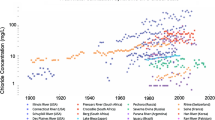Abstract
The eastern Dundas Tablelands resulted from a series of volcanic events some 400M years ago, and apart from uplift and erosion, has undergone little change since then. It is proposed that reduced conditions inherent in volcanic material remain deep in the landscape, and that deep groundwater flow equilibrates with this. The chemistry of sulphur and reaction with iron is discussed, and it is proposed that sulphate reduction provides a means whereby the reducing capacity can be transmitted in the flowpaths towards the discharge zones. Over time all readily reduced material has been stripped from these flowpaths, so that reduced groundwater is able to reach the surface, typically at sites of preferential flow for deep groundwater (ie cracks and fissures in the regolith). Disturbance of the discharge areas has introduced reducable material into these flowpaths resulting in severe chemical scalding within the overall degradation due to salinity. Novel remediation processes are suggested.
Similar content being viewed by others
References
Burner R A 1970 Sedimentary Pyrite formation. Am. J. Sci. 268, 1–23.
Brock T D, Madigan M T, Martinko J M and Parker J 1994 Biology of microorganisms. Publ Prentice-Hall 7th ed. Evolution of the earth and earliest life forms.
Cayley R A and Taylor D H 1997 Grampians special map area geological report. Geological Survey of Victoria Report 107.
Fanning M 1991 Single and multi-grain U-Pb zircon dating of the Rocklands Rhyolite. Geological Survey of Victoria unpublished report 1991/6.
Licht S 1988 Aqueous solubilities, solubility products and standard oxidation reduction potentials of the metal sulphides. J. Electr. Soc. Electrochem. Sci. Technol. 135, 2971–2975.
Munroe M 1998 Salinity discharge mapping for the Dundas Tablelands in the Glenelg salinity region. Dept. Nat. Res. and Environ., Victoria.
Newman E I and Watson A 1977 Microbial abundance in the rhizospere- A computer model. Plant Soil 48, 17–56.
Roberts W M B, Walker A L and Buchanan A S 1969 The chemistry of pyrite formation in aqueous solution and its relation to the depositional environment Mineral. Deposita 4, 18–29.
Rovira A D 1969 Plant root exudates. Bot. Rev. 35, 35–37.
Author information
Authors and Affiliations
Corresponding author
Rights and permissions
About this article
Cite this article
Gardner, W.K., Fawcett, J.D., Fitzpatrick, R.W. et al. Chemical reduction causing land degradation. I Overview. Plant Soil 267, 51–59 (2004). https://doi.org/10.1007/s11104-005-3967-8
Received:
Accepted:
Issue Date:
DOI: https://doi.org/10.1007/s11104-005-3967-8




